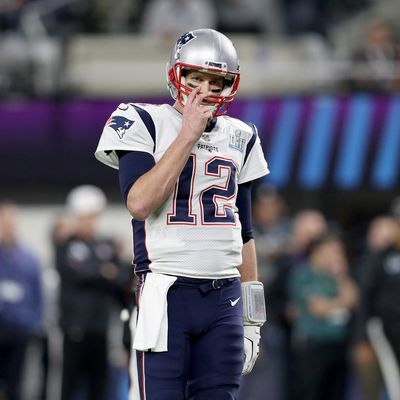
A decision in New York federal court yesterday has the potential to shake the very foundation on which the modern internet is built, changing the way websites from huge publications to one-person blogs do business online. The case concerns, naturally, Tom Brady and Snapchat.
In 2016, Justin Goldman captured a photo of New England Patriots quarterback Tom Brady and Celtics general manager Danny Ainge on a Hamptons sidewalk. The meeting led to speculation that Brady was being used to try and woo Kevin Durant to the Celtics. He later uploaded the photo to Snapchat, where it went viral after being scraped from there and uploaded to Twitter by various users (one user cited in the case appears to have been hit with a copyright takedown, another has not).
Some tweets containing the image are now gone, but one that’s been archived in a write-up is captioned, “Boston’s recruitment team for KD in Hampton’s @CSNNE @WojVerticalNBA @StoolGreenie @stoolpresidente @sam_amick pic.twitter.com/IEQxO7xCzg.” The user who scraped it from Goldman’s Snapchat presumably wanted it to get picked up by sportswriters, tagging them in his post. That tweet was also quote-tweeted by at least one sports journalists to his 204,000 followers. And the tweet was, naturally, embedded on a number of sports news websites.
Goldman proceeded to sue the various media outlets who embedded the tweeted screenshots on their site, claiming that they’d infringed on his copyright. The defendants in the case are Breitbart, Heavy.com, Time Inc., Yahoo, Vox Media, Gannett Company, Herald Media, Boston Globe Media Partners and New England Sports Network. A Boston Globe tweet containing the image remains live.
If you haven’t already noticed, this recap of the court case contains no embedded uses of the photos, so you can probably guess how the court ruled.
“Having carefully considered the embedding issue, this Court concludes, for the reasons discussed below, that when defendants caused the embedded Tweets to appear on their websites, their actions violated plaintiff’s exclusive display right,” Judge Katherine Forrest wrote. “The fact that the image was hosted on a server owned and operated by an unrelated third party (Twitter) does not shield them from this result.”
What Forrest is referring to is a technical distinction between hosting and embedding online. Hosting content on a website means that the data is stored on servers in your possession or control. For instance, if I upload a photo to the servers in my apartment that contain my personal public website, that’s hosting. Embedding is the practice of inserting computing code that grabs content from a third-party host. The best example of this is YouTube — I could add a YouTube player to my website, but the video data is sent from a server owned by YouTube, not me.
This distinction is important, because other cases (such as Perfect 10 v. Amazon.com) have hinged on the so-called “Server Test,” the idea that where the content is hosted determines whether copyright has been infringed upon. Multimedia embeds, even if they function the same as hosted content, could technically be defined as links to retrieve content from someone else’s server. The “server test” distinction has allowed publishers, both amateur and professional, to get away with … a lot. Maybe instead of paying hefty licensing fees for a photo, a site could embed a version that less scrupulous users uploaded to social media.
Regardless of whether content is hosted or embedded, the end result is the same: a user visiting a webpage sees a collection of text and images and video all presented as one cohesive package. For this reason, Judge Forrest sided against the media outlets who had embedded Goldman’s photo. “The plain language of the Copyright Act, the legislative history undergirding its enactment, and subsequent Supreme Court jurisprudence provide no basis for a rule that allows the physical location or possession of an image to determine who may or may not have ‘displayed’ a work within the meaning of the Copyright Act,” she wrote.
Because the sites embedding the tweets did so consciously, making a choice to include embed code in their articles and blog posts, the court ruled that they had willfully chosen display the photograph. There is a significant difference between linking to content by embedding it and linking to content via a standard click-through hyperlink.
The defendants in the case warned that a decision against them could have a “chilling effect” on how the web works, and their fear is not unfounded. Much of the modern digital content economy hinges on practices that might not be entirely legal. Many social platforms have share buttons (retweet, reblog, and in beta, regram), allowing users to take someone else’s content and distribute it under their own banner. The booming hobby and business of video-game streaming is both vital to the industry at this point, and possibly illegal.
The internet at its core is about sending things around to other people and sharing them quickly and easily. Intellectual property disputes, catalyzed by this ruling, could theoretically (theoretically!) gum up the works.





























